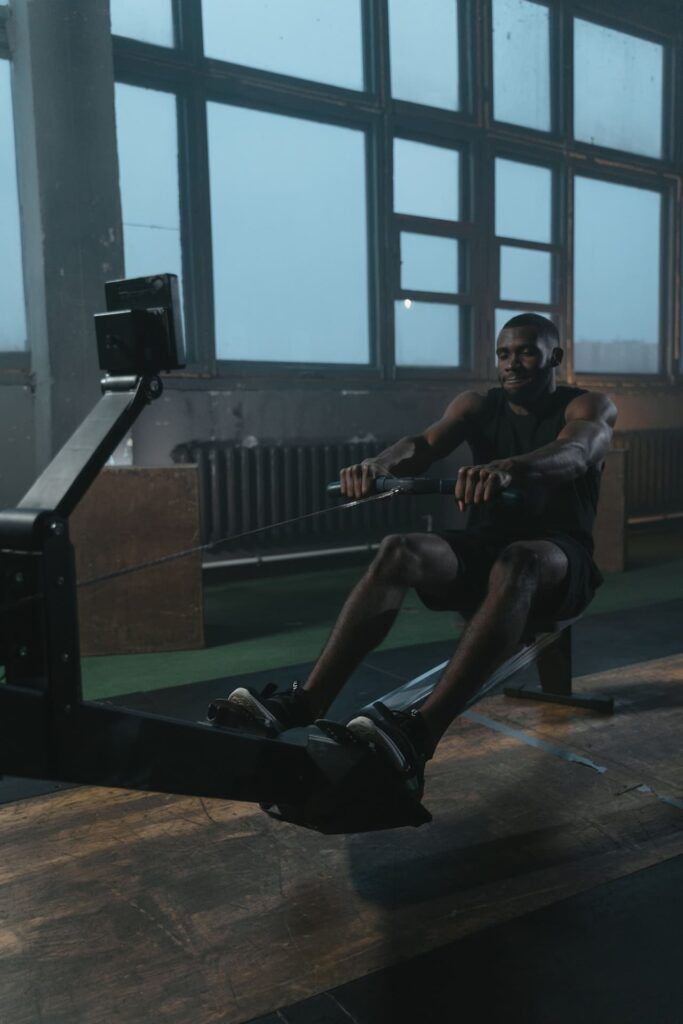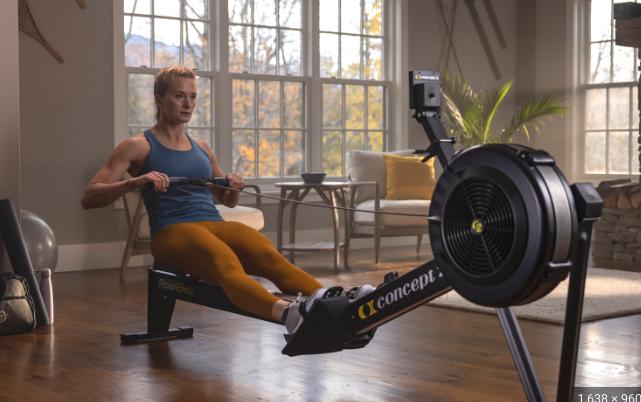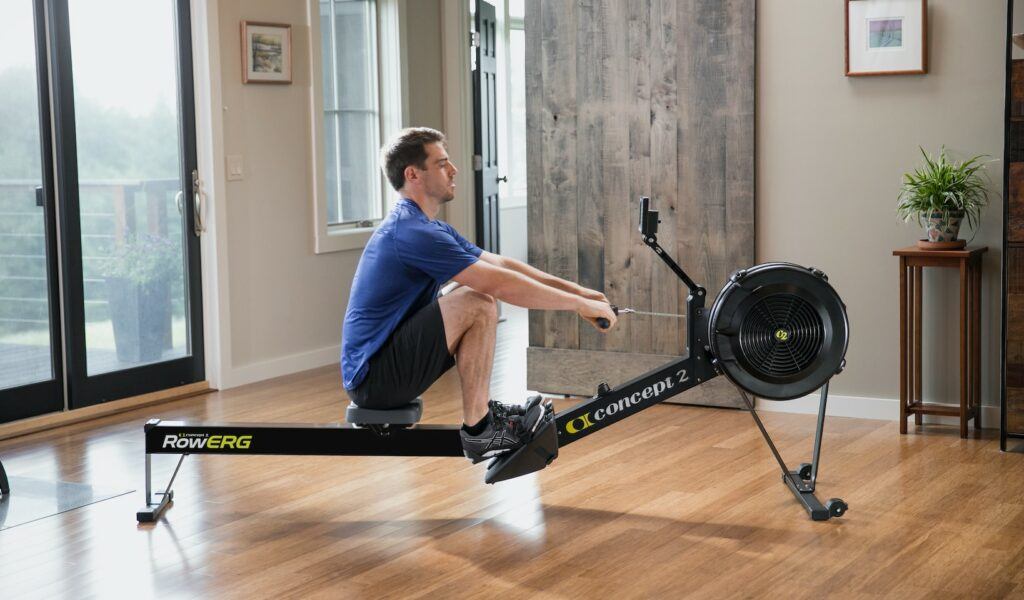Air Rower vs Magnetic Rower
Have you ever wondered what the difference is between an air rower vs magnetic rower? I know I have!
Many people aren’t even aware that both types exist. We’ve all seen rowing machines at the gym, but have you ever stopped to think about whether it’s an air rowing machine or magnetic rowing machine? Most people just hop on and start rowing without a second thought!
Although both machines work out the same muscles, they actually have quite a few differences that can make a big impact on your workout and if you are thinking of buying either a magnetic rower or air rower it’s worth knowing the differences before you buy one.
Factors like noise level, data accuracy of monitors, resistance operation, and machine weights can all play a role in which machine is right for your home gym.
Don’t worry though, I’ve got you covered! In this article, I’ll break down all the similarities, differences, and operating methods of air rowing machines vs magnetic rowing machines to help you make the right choice.
So, whether you’re a seasoned rower or just starting out, keep reading to learn more!
Air vs Magnetic Rowers: Our Top Picks
Top Magnetic Option: Hydrow Rower (See price at Amazon)
Best Budget Magnetic: Sunny Health & Fitness SF-RW5854 (see price at Amazon)
Best Air Rower: Concept2 Row Erg (see price at Amazon)
Best Budget Air Rower: Stamina Air Rower 1399 (see price at Amazon)
Air Rowing Machine vs Magnetic Rowing Machine
As you compare air and magnetic rowing machines, you’ll likely discover that they have more similarities than differences. There are great rowers available in both categories, and you can see my top pick in this guide to the best rowing machine.
Air Rower vs Magnetic Rower Similarities
Here are some of the biggest similarities, this is not an exhaustive list, just the most important ones:
- Both machines use a handle and strap that are connected to a flywheel as the primary pulling mechanism.
- The same rowing technique is used on both air and magnetic rowers.
- The same muscle groups are engaged during the workout on both machines.
- Both have a similar-sized footprint and can (sometimes) be folded up for storage.
- Air rowers and magnetic rowers are both available for a range of prices from budget to high-end.
Magnetic Rower vs Air Rower Differences
The key differences to keep in mind are:
- Air rowers produce noise, while magnetic rowers are nearly silent.
- Air rowers offer resistance based on the speed of your rowing, while magnetic rowers provide a set level of resistance that remains the same regardless of your rowing speed. To increase the resistance, you must adjust the level manually. (The exception to this is the awesome Hydrow which is magnetic but uses computer wizardry to increase resistance as you row harder)
Key Differences between Air Rowers and Magnetic Rowers
| Air Rowing Machines | Magnetic Rowing Machines | |
|---|---|---|
| Resistance | Air on a fan flywheel. | Magnets move closer or further from a metal flywheel. |
| Resistance Control | The faster you row, the more resistance you feel. | Adjustable resistance. |
| Resistance Strength | Row fast to feel high resistance strength. Mimics the resistance felt while rowing on water. | Strength is determined by resistance level setting. You can row slowly at a high level and feel strong resistance. |
| Noise Level | The fan is quite noisy. You’ll need to turn your TV up. | Almost silent- Can use while watching TV. |
| Monitors | Can very accurately record data. Perfect for tracking data, competing, and training. | Great for preset workout programs and streaming. Not as accurate data for competitive rowers. |

Air Rowing Machine
If you’re looking for a versatile and efficient home rowing machine, air rowers should definitely be on your radar.
Not only do they offer a smooth and strong rowing stroke, but they also come in a wide range of price points, making them accessible to everyone.
One of the biggest advantages of air rowing machines is that they closely mimic the resistance you feel when rowing on water. This makes them a favorite among fitness enthusiasts and a powerful training tool.
It’s worth noting that air resistance rowers are the top choice of Olympic athletes, which is a testament to their outstanding performance.
Air Rower Resistance
Let me break down how an air rowing machine generates resistance. Simply put, the machine uses wind or air to create resistance as you row.
Here’s how it works:
When you pull the handle, a “fan flywheel” spins, moving the air particles in front and to the side of it. The air particles create drag, which requires force to move.
As you row faster, the flywheel spins faster and moves more air particles. The more particles in the air, the greater the drag or resistance, requiring even more force to move.
The cool thing is that this resistance is variable and essentially infinite.
There are no resistance settings on an air rower, so the faster you row, the more resistance you’ll feel.
It’s an exponential relationship where doubling your speed requires eight times as much force!
It works just like you were in a real rowing boat, which is why air rowing machines are such an excellent tool for mimicking the resistance you feel while rowing on the water.

Air Rower Damper Settings
The damper setting controls the amount of air that enters the flywheel housing, which in turn affects the amount of drag on the flywheel.
A low damper setting, like 1, will let in a small amount of air, while a higher setting will allow more air inside.
This control over the air intake allows you to adjust the perceived weight of each stroke. The more air that enters the flywheel, the heavier the stroke will feel.
However, it’s essential to note that the damper setting is not the same as resistance settings.
According to Concept2, the damper setting is comparable to bicycle gearing: it affects the feel of the rowing stroke but does not directly alter the resistance level.
So, if you’re looking for a way to fine-tune your rowing experience, the damper setting can be an excellent tool for adjusting the perceived weight of each stroke.
Air Rower Monitors
Monitors on air rowing machines can range from basic to advanced, depending on the model’s price.
What’s great about some air rowers is that their monitors can accurately calculate the drag on the flywheel and its deceleration rate during your recovery stroke.
In other words, these monitors can be incredibly precise, tracking your distance, time, and power output.
This level of accuracy makes it possible to compare scores across different users and machines, which is why air rowers are the go-to choice for Olympic athletes, indoor rowing competitions, and world record attempts.
Advanced air rower monitors can also track additional metrics such as 500m split, heart rate, force curve, pace boat, and more.
No other type of rowing machine monitor can match this level of accuracy and data tracking.
Here are some other features that are of air rowing machines:
- Ideal for HIIT (high-intensity interval training) because of the ability to quickly adjust speed and resistance.
- Relatively lightweight since the resistance is created by a plastic fan.
- The fan generates a fairly loud “whooshing” noise when in use, making it unsuitable for those who want to watch TV while exercising.
Magnetic Rowing Machine
Magnetic rowing machines provide a smooth and powerful rowing experience similar to air rowers, and are available in all price ranges with varying features and quality.
One significant advantage of magnetic resistance is its near-silent operation and inclusion of pre-programmed workouts in its performance monitors.

How do Magnetic Rowers Work?
Unlike air rowers that rely on displacing air around the flywheel, magnetic rowers use eddy currents created by a magnet in their flywheel to resist the spinning and generate resistance.
By adjusting the dial, you can increase or decrease the resistance level by changing the braking force.
However, unlike air rowers where the resistance level is determined by the user’s rowing force, magnetic rowers maintain a constant resistance level regardless of the applied force or input.
So, magnetic rowers have a set resistance level that remains the same, irrespective of the rowing power applied.
This is one area where magnetic rowers differ from air rowers.
The exception is the awesome Hydrow which is magnetic but automatically adjusts the resistance level based on your stroke power (using computer wizardry).
Magnetic rowers are virtually silent and offer pre-programmed workouts in their performance monitors as some of the main benefits of magnetic resistance.
Magnetic Rower Resistance
All magnetic resistance rowing machines function on the same principle, although they may differ slightly in their adjustment methods.
The mechanism of magnetic resistance involves moving a magnet closer or farther from a metal flywheel. The resulting “eddy currents” from the magnet interact with the flywheel, causing it to decelerate. The closer the magnet is to the flywheel, the more it slows down due to the eddy currents.
In simple terms, the closer the magnet to the flywheel, the greater the resistance. Conversely, the farther the magnet, the less resistance.
This is unlike air rowers, where the resistance varies based on your rowing speed.
Once you set the resistance level on a magnetic rower, it remains constant, regardless of your rowing speed.
For instance, if you set the resistance to level 5, you will feel the same resistance whether you row fast or slow.
To increase the resistance, you must adjust the resistance level manually, either by turning a dial or pressing a button on the monitor.
Magnetic Rowing Machine Monitors
The monitors on magnetic resistance rowing machines vary in complexity, ranging from basic to advanced models that can track numerous data points, feature games, and offer preset workout programs.
One popular feature of some monitors is the ability to choose from preset workout programs, which may require the machine to be plugged into an outlet.
These monitors are often backlit and can adjust the resistance automatically as you row. For instance, you could select a “Mountain Workout” and the monitor would gradually increase and decrease resistance to simulate climbing and descending a mountain.
An example of a monitor with preset workout programs for a magnetic rowing machine is shown below.
Despite their benefits, magnetic rower monitors are not as precise as those on air rowers, which can impact their ability to accurately compare scores and times with other rowers worldwide.
Nonetheless, the data recorded by magnetic rower monitors is still accurate enough for personal use.
Other Features
Here are some additional features that are common or unique to magnetic rowing machines:
- The resistance is virtually silent because magnetic braking does not involve any “part-on-part” contact, making them ideal for use while watching TV or in small apartments.
- Magnetic rowing machines can be heavy due to the presence of heavier flywheels.
- Some magnetic rowing machines require to be plugged into an outlet.
How Do You Adjust the Resistance on air vs magnetic rowing machines
By now, you may have learned that both air and magnetic rowing machines provide resistance to exercise your legs, core, back, and arms. However, the way these machines allow you to adjust the resistance differs.
Let’s start with magnetic rowing machines. They utilize a magnet in the flywheel to create a magnetic resistance that restricts the flywheel’s spinning.
This means that the magnet produces a braking force that you will counter while rowing.
Typically, magnetic rowers feature a resistance knob that you can turn to adjust the resistance. By turning the knob, you can bring the magnet closer to the flywheel, increasing the resistance, or move the magnet away from the flywheel, reducing the resistance.
Air rowing machines often have a damper lever on the side of the cage that encloses the flywheel.
This lever allows you to adjust the damper from 1 to 10, with the highest setting providing the most resistance.
Setting the damper to 1 lets in less air into the flywheel housing, meaning less force is needed to operate the rower. Conversely, setting the damper to 10 lets in more air, requiring more power to spin the flywheel.
So, the way you set the resistance level varies slightly between an air rowing machine and a magnetic rowing machine but both air rowers and magnetic rowers offer varying levels of rowing challenges.
Is More Air into the Flywheel Cage the Key to Increased Resistance on an Air Rower?
No, increasing the amount of air in the flywheel cage does not increase resistance; it only increases the difficulty of rowing.
Air rowing machines use the air around the flywheel to generate resistance, and you can adjust the amount of air entering the flywheel housing by using the damper setting.
When the damper lever is set to 10, the maximum amount of air is allowed into the flywheel housing, which makes it more difficult to row because the flywheel has to displace more air with each stroke.
However, increasing the damper setting to 10 only increases the rowing load and not the resistance.
The resistance on an air rowing machine is generated by the wind that the flywheel generates as you row. The faster you row, the more wind is created, and the more resistance you will experience.
Therefore, the damper setting does not change the resistance but affects the difficulty of rowing. The harder you row, the more wind is generated, and the more resistance you will feel.
What’s the Difference in Noise Levels Between Air and Magnetic Rowers?
Air rowing machines are louder than magnetic rowing machines, and this is one of the key differences between the two types of rowers.
Since air is a fluid, similar to water, it creates a whooshing sound as the flywheel blades move through the air.
The water-like sound generated by air rowing machines can create a dynamic and refreshing environment for indoor exercise, but it also means that they are generally louder compared to magnetic rowers.
For example, a Concept2 air rower can produce noise levels of up to 74 decibels during maximum rowing stroke power.
In contrast, a Hydrow magnetic rower produces noise levels of around 64 decibels during high-intensity rowing strokes.
So, if you prefer to exercise while watching TV or in a quieter environment, a magnetic rowing machine may be a better option for you.
Check out my guide to the quietest rowing machines.
magnetic rowing machine vs air rowing machine – Which is best for Competitive Rowers?
A competitive rower would usually want a rowing machine that is able to accurately monitor their performance. This is an area where an air rower is better than a magnetic rower, with unmatched accuracy in monitoring workout data.
The precision of air rowers is particularly beneficial for tracking resistance levels, applied force, and deceleration during recovery.
These rowing machines also provide accurate measurements of metrics such as 500m split time, heart rate, and distance covered.
As such, an air rower is a preferred choice for competitive rowers who value precise data tracking during their training sessions.
Do Rowing Machine Monitors Need Electricity?
Yes, the monitor on your rowing machine typically requires electric power to function. Simpler monitors can be supplied by AA batteries but rowers with fancier touchscreens will need to be plugged into a wall outlet.
It is important to check the specifications of your preferred rowing machine before purchasing it, as different types of rowers may have varying power requirements for their monitors.
For instance, magnetic rowers are more likely than air rowers to require a wall outlet for electric power to operate their monitors.

Can I Fold My Rowing Machine After a Workout?
Many rowing machines, such as the Concept2, are designed to be folded after exercising for easy storage. This makes them ideal for apartments or spaces with limited room.
The Concept2 rowing machine not only offers a compact-saving design but also features a performance monitor that displays important workout data in real-time. This allows you to track your progress and compare notes with other competitive rowers.
When looking for a rowing machine for your home gym, it’s worth thinking about whether you need to pack it away between workouts or have the space for a model that does not fold.
Many of the newer rowing machines, like Hydrow and Ergatta have been designed to look elegant and take pride of place in your living room.
Can you combine air and magnetic resistance?
An air-magnetic rowing machine combines the resistance techniques of both air and magnetic rowers, providing the best of both worlds.
These rowers offer more resistance power than magnetic resistance rowing machines, as they feature a dual resistance mechanism.
With two resistance mechanisms to work against, you can use more power and achieve greater workout results.
If you’re interested in an air-magnetic rowing machine, the Sunny Health & Fitness rower might be a good option.
It has a resistance knob that allows you to vary the resistance from 1 to 12, and you can increase the resistance by pulling the handlebar harder.
This rower also features a large LCD console that displays your workout progress, as well as transportation wheels for easy portability and non-slip foot pedals for safety.
magnetic vs air rower: Final Thoughts
When it comes to choosing between magnetic vs air rowing machines, there’s no right or wrong answer. Both types have excellent models at different price points and are highly respected in the world of fitness equipment.
So, which indoor rowing machine should you go for?
Well, that depends on your preferences. If you like to row while catching up on your favorite TV show, a magnetic rower is your perfect match.
But if you’re the competitive type who wants to race against people worldwide and compare data, then an air rower is your best bet.
For those looking for the cream of the crop, the Concept2 Row Erg is a fantastic air rowing machine. It has outstanding resistance, damper settings, the best monitor, and is reasonably priced.
If you prefer to go for a magnetic rower, the Hydrow Rower is the best rowing machine available.
(I have written a post comparing Hydrow vs Concept2)
For those on a tighter budget, the Stamina Air Rower 1399 is the best air rowing machine under $500. While the Sunny Health & Fitness SF-RW5854 is the best budget option if you fancy a magnetic rower.
So there you have it, folks! I hope my article has given you a clearer understanding of the differences between air and magnetic rowing machines. If you have any questions, drop them in the comments section below!
*As an Amazon Associate I earn from qualifying purchases.
